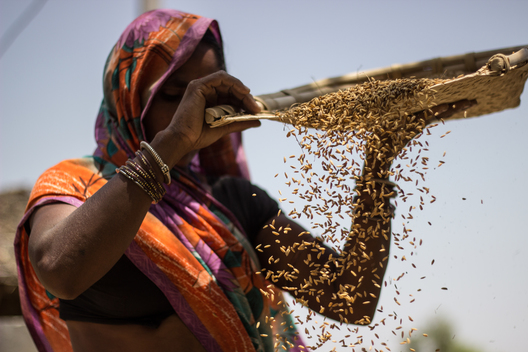Prime Minister Narandra Modi’s announcement of India achieving Net Zero emissions by 2070 is the right intention. The target of 2070, problems with net-zero can be questioned and argued but that can be debated later as well. This is the time to thoroughly decipher what the prime minister has committed before the world in his Glasgow speech.
The ‘Panchamrit’ formula can be presented as the roadmap for achieving the Net Zero target, but is it comprehensive enough? In my opinion, the formula lacks the finer elements that are essentially required to make it foolproof. For example, while it does speak about energy transition and efficiency, it barely addresses the issue of methane, nitrous oxide and sulphur that are mainly emitted during industrial agricultural practices.
Synthetic agrochemical-based Industrial Agriculture is responsible for around 1/5th of the global emissions. A recent research by Greenpeace, Institute of Agriculture and Trade Policy (IATP) and GRAIN provides the first estimate of the global climate impacts of synthetic Nitrogenous fertilisers, across the entire production chain from manufacturing to soil application. The research suggests, “The production and use of synthetic N fertiliser accounts for 2.4% of global emissions, making it one of the top climate polluting industrial chemicals. The synthetic N fertiliser supply chain was responsible for estimated emissions of 1,250 million tonnes of CO2e in 2018, which is roughly 21.5% of the annual direct emissions from agriculture (5,800 million tonnes). For comparison, the global emissions from commercial aviation in 2018 were around 900 million tonnes of CO2.”

In addition, 5.8% of the global emissions comes from livestock & manure management in the form of methane and Nitrous Oxide. N2O is a persistent GHG with 265 times more global warming potential than Carbon dioxide whereas methane has 80 times more warming power when compared to C2O.
Unfortunately, the catastrophic impacts of synthetic Nitrogenous fertiliser is not limited to choking the atmosphere. When applied to farms, only 20-25% of the fertiliser is consumed by the crops, the remaining amount contaminates the groundwater with the toxic nitrate and then causes eutrophication and deoxygenation in the rivers and oceans leading to formation of dead zones. The IUCN report on Ocean Deoxygenation has found that over the past 50 years, global dissolved oxygen in the ocean has decreased by ~2% and scientific data indicates that this trend is set to continue. The ocean as a whole is expected to lose about 3–4% of its oxygen inventory by the year 2100 under a “business-as-usual” scenario (RCP8.5) with most of this loss concentrated in the upper 1000m where species richness and abundance is highest. I am not sure if it is just coincidence that since 1960, there’s been a 800% jump in synthetic N fertiliser use and a corresponding increase in dead zones in the oceans, from mere 49 in 1960 to 400, that’s again 800%.
A study done by the Resplandy group reveals that the ‘entire coastline in the northern Indian Ocean is hypoxic during at least one month of the year.’ These dead zones are dangerously altering the marine life-systems and are posing severe threats to the food security and livelihoods of hundreds of millions of people across the world. Not only that, scientists believe that ‘ocean deoxygenation may also influence the movement of gases between ocean and the atmosphere and deoxygenated deeper ocean waters produce greenhouse gases such as nitrous oxide, carbon dioxide and methane that may reach the ocean surface and be released into the atmosphere, contributing to further warming.’ Another Smithsonian-led study suggests that ‘nearly all ocean dead zones will increase by the end of the century because of climate change and almost 94% of these hypoxic areas will experience warming of 3.6 degrees Fahrenheit or more by the end of the century.’
Extreme weather events and ocean heating are directly linked phenomena. Senior climate scientist, Ilissa Ocko, in her article writes, “Scientists are detecting a stronger link between the planet’s warming and its changing weather patterns. Though it can be hard to pinpoint whether climate change intensified a particular weather event, the trajectory is clear — hotter heat waves, drier droughts, bigger storm surges and greater snowfall.”
Addressing the issue of emission without adequately dealing with the problem of nutrient pollution caused by agrochemical abuse can only be considered superficial at best. How can it be possible that on one hand we promote solar and other non-fossil fuel based energy and on the other we spend 80-90 thousand crore rupees on chemical fertiliser subsidies which will ultimately endanger our food and nutritional security and sovereignty and the livelihoods of crores of Indians? Our future lies in the actions we are taking now. If we are serious about our Net Zero targets, we need to reimagine our agriculture systems and other developmental programmes in a way that leads us towards agricultural sustainability. Each of our steps should create footholds so that we flatten the curve before it is too late.
(Ishteyaque Ahmad is a senior agriculture campaigner at Greenpeace India)



